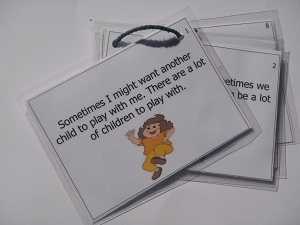Social Stories for Teaching Appropriate Behavior
 Social stories are brief descriptive stories that provide accurate information regarding a social situation all children must learn to handle. The goal is to help a specific child with communication and behavioral challenges understand social situations, expectations, social cues, new activities, and/or social rules encountered in typical daily routines and interactions. Parents, teachers, and caregivers can use these simple stories as a tool to prepare a child for a new situation, to address problem behavior, or to reinforce emerging skills.
Social stories are brief descriptive stories that provide accurate information regarding a social situation all children must learn to handle. The goal is to help a specific child with communication and behavioral challenges understand social situations, expectations, social cues, new activities, and/or social rules encountered in typical daily routines and interactions. Parents, teachers, and caregivers can use these simple stories as a tool to prepare a child for a new situation, to address problem behavior, or to reinforce emerging skills.
A social story is written in the first person about a specific child using developmentally appropriate language. The stories incorporate a child’s familiar words, people, situations and pictures, and describe his or her feelings and perspectives (Broek, 1994). Each story should:
- Congratulate or applaud a child’s skills, abilities, personality traits or achievements; and
- Introduce words and behaviors that are considered desirable for a child to use in a specific social situation.
Resources
-
Examples of social stories
Center on the Social Emotional Foundations for Early Learning - Guidelines for writing social stories
-
A social story about learning to clean up
Allegheny County Public Schools, Early Childhood Technical Assistance Center
An effective social story shares accurate social information in an objective and reassuring manner so that is easily understood by the reader (or listener). Social stories are written for a particular child to help him or her cope with a specific situation. The child hears how he or she (the main character) successfully navigates a difficult situation e.g., sharing toys, and learns new behaviors via a “self-as-model” strategy.
Reading and/or listening to a story about how to make friends, or what to say to a peer who is annoying, is a form of coaching and modelling. Often a child will request to hear a particular story over and over, and through an improved understanding of events and expectations, eventually learns more effective responses.

